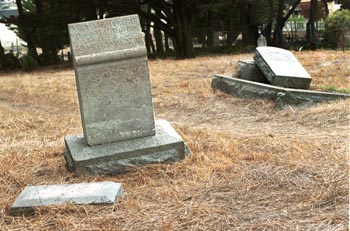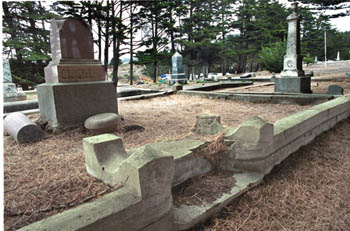![[Metroactive Features]](/features/gifs/feat468.gif)
[ Features Index | San Jose | Metroactive Central | Archives ]
 Photograph by George Sakkestad Soul Proprietors: This cemetery at Half Moon Bay exemplifies the neglect that can befall a graveyard once it is full and no new customers are being sought. Grave Consequences Sometimes developed and vandalized, or just left to the weeds, some old graveyards are finally winning protection in the open space and historical preservation movement. But not all of them. SETTLED DOWN AT THE BOTTOM of a draw, along a shallow creek in south San Jose, the town of New Almaden is a small marvel of historical preservation. To be sure, there was much to preserve. New Almaden's mines were not only the first in California, but among the most important; the mercury found there was essential to the process of gold and silver mining. At its peak, in the 1870s, New Almaden was a busy and lively town. The population hovered around 4,000 and consisted of miners from as far away as England, Mexico and Chile. There were three schools, three major stores, a volunteer fire department, dormitories, a hotel and a doctor. But like all of the historic mining towns, the prosperity didn't last, and by the early 20th century the population began to dwindle. FOR A TOWN that played such a seminal role in California mining, New Almaden remains relatively obscure. Getting there is easy: eight miles south on the Almaden Expressway from Highway 85, plus a few more on Almaden Road. You know you're there when you see a "Welcome" banner strung across the road, or La Casa Grande, the unmistakable mansion built in 1854 and now serving as the town's historical museum. Certainly one of the most intriguing of the town's surviving artifacts is the Hacienda Cemetery. Located on a scenic residential back road, across the creek from the museum, it's easy to miss. There's a sign, but it is slightly faded and pushed off the road. Along with being one of the more notable historic sites, the Hacienda Cemetery is also one of the least likely to have survived. The land on which the Hacienda Cemetery sits has been bought and sold several times, and only through a tax sale, in 1947, did it come into more caring hands. The family of songwriter Ben Black, once famous for "Moonlight and Roses," purchased the land in the 1920s and, in 1928, Black decided to "make improvements" by driving a road through the cemetery--directly over an untold number of graves. A lawsuit brought years later on behalf of the desecrated grave owners describes Black's activities this way: "That on the 10th of May, A.D., 1928, said defendants in person, and/or through their agents or servants, did break down the fences surrounding the cemetery and did enter with scrapers and did proceed to build a road through the cemetery." Matters, fortunately, improved from there. The California Pioneers of Santa Clara County, a local historical society, managed to pick up the land for cheap almost 20 years later, and since then a number of genuine improvements have been made. The Pioneers, along with a variety of volunteers ranging from Boy Scouts to local fraternities, have managed to get the cemetery into perhaps its best shape of the last hundred years. The preservation work has really been twofold: not only have the physical grounds--the fauna, the gravestones, the fencing, etc.--been cleaned, rebuilt and maintained, but the narrative history has also been saved. The property is small but not cramped, without landscaping or adornment, and the bottom half slopes down to the creek's edge. Footpaths wind in and around myrtle, oaks and laurels, and there is even some poison oak. Appropriately, each grave is enclosed by its own individual picket fence. Not every one still has a gravestone, but most do. Some of the lichen-scarred markers are still legible, while the writing on others has weathered away. There is even a sturdy wood headstone with a faint but visible etching. Near the entrance, the Pioneers have erected a glass case containing everything from a section of the General Cemetery Act to a list of the buried to relevant newspaper articles. Like most cemeteries from this era, the Hacienda reveals an often arduous past. In this case, approximately 50 percent of the buried are children. The Perez family, for instance, lost a 1-year-old on June 10, 1873, a 2-year-old on June 11, 1873, and another 1-year-old on August 24, 1874. One of the more lurid stories is that of Bertram Barrett. In 1898, Barrett, aged 13, lost his arm in a hunting accident. Because the law at the time required that severed limbs be given a proper burial, Barrett did so in the Hacienda Cemetery. The arm is still there--it's even marked with a gravestone--but the rest of Barrett is buried down in the valley at Oak Hill.
CEMETERY preservation is as much a concern today as it has ever been and, unfortunately, the fate of the Hacienda Cemetery is not typical. Rampant urban expansion into rural areas is a major threat. Vandalism, of course, has always been a problem, ranging from mindless destruction of gravestones to outright grave robbing. While regulations exist in California to govern the use of old cemetery land, the laws are often unknown, overlooked or plagued with egregious loopholes. But if threats are increasing, so is interest. The most basic Internet search reveals a number of sites dedicated to the protection of historic burial grounds. One of the more active organizations is SavingGraves.com, whose mission is to protect "human burial sites from unauthorized and unwarranted disturbance, by man or nature." It is the group's objective "to highlight their [cemeteries] importance and promote an attitude of reverence and respect, while encouraging further preservation of these unique historical resources." SavingGraves.com is going as far as circulating a petition for a National Cemetery Protection Act that would "define the rules and regulations concerning these historic national treasures, and at the same time making clear the penalties for infractions of this law." One of the more visible local examples of a historic graveyard that has not been maintained is the old Half Moon Bay Cemetery on Highway 92. The property holds two cemeteries, though only a fence separates them. The lower cemetery, which is owned by a local Catholic church, is still cared for, but the upper cemetery clearly is not. It has been passed from owner to owner and, at least recently, has seen nothing in the way of upkeep. The cemetery is worse than an eyesore; it is sad and disrespectful. There are a number of beautiful and elaborate tombs on the property, going back as far as the 1860s, but many have been knocked over and broken. Others are missing altogether. There isn't a blade of grass still living, and trash--beer bottles, plastic cups, paper bags--litters the grounds. Will modern, active cemeteries face this same problem 100 years from now? They shouldn't. Most are Endowment Care cemeteries, meaning that for every grave they sell, a percentage of the proceeds goes into a fund that will pay for and ensure upkeep for posterity. Of course, there are other ways for a cemetery to be preserved. The site of the former Agnews State Mental Hospital, along with its weedy, largely unmaintained cemetery that holds mostly casualties from the 1906 earthquake, was recently purchased by one of the wealthiest companies in the world, Sun Microsystems, to be its new campus. As part of the deal, Sun agreed to rehabilitate and repair the cemetery and then turn it over to the city. Work is currently underway.
BACK IN New Almaden, beyond the old homes and historic structures, is the Almaden Quicksilver County Park. The park comes right to the edge of town and encompasses almost 4,000 acres, among which is one of most scenic and historic graveyards in the area, the Hidalgo Cemetery. Part of its allure is that you can't drive there--getting to it requires a three-mile hike. The trailhead can be picked up down the street from the museum. The path is steep at first, and can be quite hot in summer. While there is cover off the trail, most of the walk is exposed to the sun. En route you pass a crumbling miner's shack, a corrugated steel storage shed with a loose flap that bangs loudly in the wind, and the remains of a church. Eventually, the trail turns off onto a narrow spur, and you follow the ridgeline around to the south. Tall grasses overhang the trail, and when you come out on top, the views are expansive. To the east you can see across the valley of south San Jose, and to the west there are outlooks further into the park. The landscape is a classic blend of coastal California flora and fauna: gangly oak trees, extensive dry grasslands and a variety of bird life. In the spring, the array of wildflowers equals any in the area. The cemetery is marked only by a sign and a stand of a dozen cedars. There are no gravestones remaining, and the grass inside is thick and grown in. As you walk around, there are depressions and loose dirt where bodies were once buried and later exhumed. Of course there are many better-maintained and more frequently visited cemeteries in California, but few evoke such a strong sense of the state's history. The hike to get here, the trail maps, the sweat and the endurance--it's as if these are a small tithe paid to visit the dead. They are, in this way, what all historic cemeteries need: evidence of commitment. [ San Jose | Metroactive Central | Archives ]
|
From the October 26-November 1, 2000 issue of Metro, Silicon Valley's Weekly Newspaper.
Copyright © 2000 Metro Publishing Inc. Metroactive is affiliated with the Boulevards Network.
For more information about the San Jose/Silicon Valley area, visit sanjose.com.

